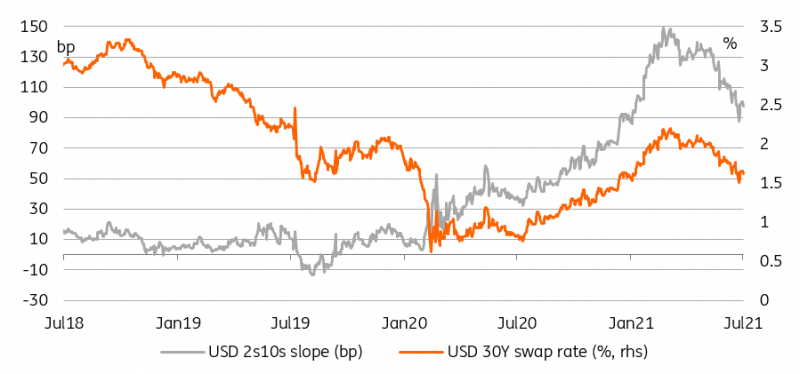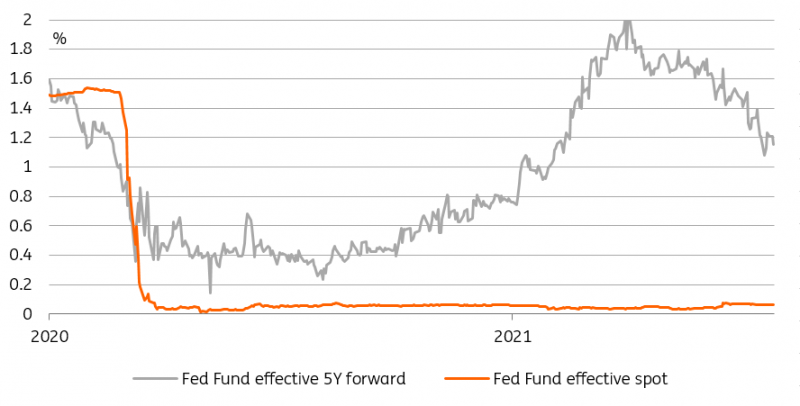The Fed should, but is unlikely to, send a strong signal on tapering. Even if these aren’t justified economically, low rates are a product of the squeezed summer bond market. This state of play is unlikely to change this week. EUR rates should prove more stable, but higher inflation could further weaken the ECB’s dovish rhetoric
Fed: Full speed in 2021, and slamming the breaks in 2022
This week will likely see the FOMC persisting in its game of macroeconomic chicken with inflation. Our economics team reckons that all this meeting will deliver is a further preparation for a tapering of asset purchases that will eventually be announced this December. Between here and then, the thinking goes, a very gradual shift in communication will prime markets for the end of QE, and allow the economy to clock more job market gains.
The Fed is still easing at full speed, resulting in flatter curve and lower rates
Source: Refinitiv, ING
This is a laudable objective but the subsequent policy tightening will prove a lot trickier to pull off. Our core view is that the $120bn/month bond purchases is to be reduced down to zero by the time of the first rate hike in September 2022, which will be followed by a second in December. To us, the Fed’s persistent dovishness in the face of persistent inflation is akin to a driver keeping their foot on the accelerator to only slam the break at the last minute.
US rates in full delusion mode
These consideration are far from the rate market’s thinking. In recent months, yield curves have shaved nearly 100bp to the expected terminal Fed Fund rate, and also delayed the date at which they expect the first hike to occur. The temptation is great to take these at face value and conclude that investors anticipate a sharp slowdown in economic activity.
The curve has priced out nearly 100bp of hikes within 5 years
While there may some legitimate concerns about the spread of the Covid-19 Delta variant, these feel to us like an attempt to fit a story to the move. The drop in interest rates has at least as much to do with heavy-handed Fed purchases, constrained supply, and illiquid summer markets. If we’re right, then QE is as much part of the solution as it is part of the problem.
Supportive technicals in the near term but the case for owning Treasuries is poor
In the near term, only a change in the Fed’s communication surrounding QE could affect this state of play and, as we wrote above, we doubt the Fed will send a strong signal this week. Granted, there is broad agreement that current yield levels do not reflect economic fundamentals but, as we are still in the ascending phase of the current Covid-19 wave, we fear that appetite to fade the move on that basis will remain limited.
Higher volatility and lower returns, not a winning combination
Source: Refinitiv, ING
Yet the case for holding treasuries at this yield level is weakening fast. Not only is the carry benefit proportionally diminished, the jump in volatility means investors should demand a greater compensation for taking the risk of owning them. There could, of course, be a period of stabilisation at current levels. This, in our view, would require at least a month of anaemic price action. By this time next month, we expect market liquidity to have recovered, and for the September supply surge to come firmly into view, hardly a recipe for stable rates.
Read the original analysis: Rates spark: Playing chicken
Content disclaimer: This publication has been prepared by ING solely for information purposes irrespective of a particular user's means, financial situation or investment objectives. The information does not constitute investment recommendation, and nor is it investment, legal or tax advice or an offer or solicitation to purchase or sell any financial instrument. Read more here: https://think.ing.com/content-disclaimer/
Recommended Content
Editors’ Picks
EUR/USD clings to daily gains above 1.0650

EUR/USD gained traction and turned positive on the day above 1.0650. The improvement seen in risk mood following the earlier flight to safety weighs on the US Dollar ahead of the weekend and helps the pair push higher.
GBP/USD recovers toward 1.2450 after UK Retail Sales data

GBP/USD reversed its direction and advanced to the 1.2450 area after touching a fresh multi-month low below 1.2400 in the Asian session. The positive shift seen in risk mood on easing fears over a deepening Iran-Israel conflict supports the pair.
Gold holds steady at around $2,380 following earlier spike

Gold stabilized near $2,380 after spiking above $2,400 with the immediate reaction to reports of Israel striking Iran. Meanwhile, the pullback seen in the US Treasury bond yields helps XAU/USD hold its ground.
Bitcoin Weekly Forecast: BTC post-halving rally could be partially priced in Premium

Bitcoin price shows no signs of directional bias while it holds above $60,000. The fourth BTC halving is partially priced in, according to Deutsche Bank’s research.
Week ahead – US GDP and BoJ decision on top of next week’s agenda

US GDP, core PCE and PMIs the next tests for the Dollar. Investors await BoJ for guidance about next rate hike. EU and UK PMIs, as well as Australian CPIs also on tap.


